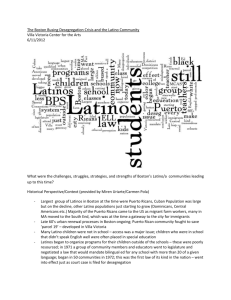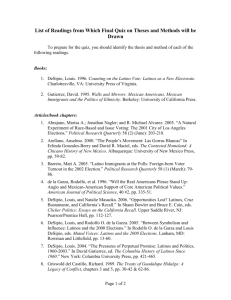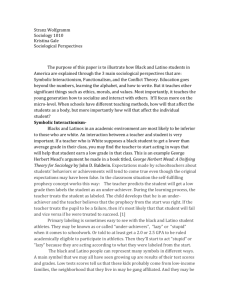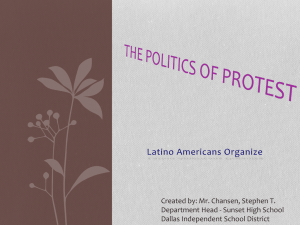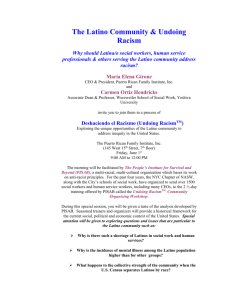Slide 1 - University of California, Davis
advertisement
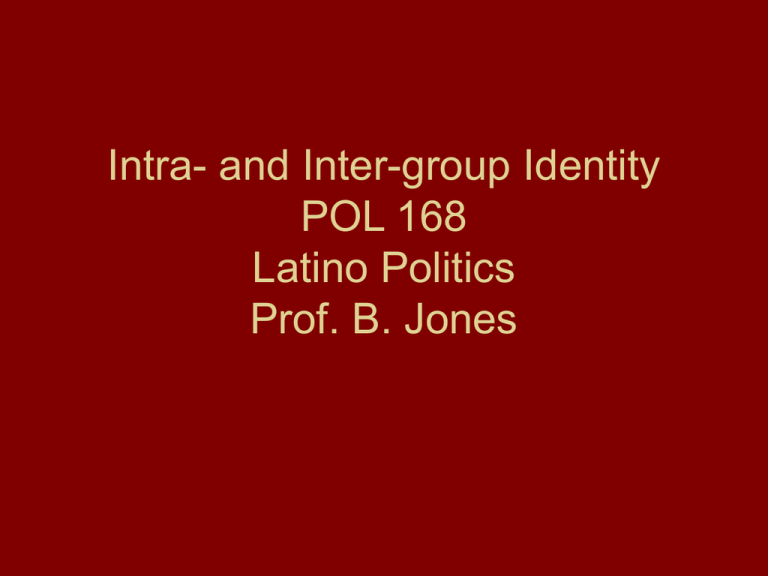
Intra- and Inter-group Identity POL 168 Latino Politics Prof. B. Jones Topics for Today • Group identity – We’ll return to the concept of pan-ethnicity – Consider mobilization efforts – And then consider inter-group commonality/competition • Latino Commonality – Why care about it? Latino Identity • Kaufmann article – Importance of Latino “Affinity” or feelings of Pan-Ethnicity – Commonality within • Some Data Analysis – 2006 Latino National Survey • Latinos’ sense of commonality with “Latinos” Latino Commonality Latino “Linked Fate” • Why might Latinos have a sense of “linked fate”? – First off, what is it?? – Does the concept apply to Latinos • 2006 LNS Data – How much does “doing well” depend on other Latinos also doing well? Linked Fate Latino Linked Fate Do Latinos see their futures, and those of their national origin group, linked to that of other Latinos? YES Mex indiv. Mex group Cuban indiv. Cuban group PR indiv. PR group Nothing 14.3 7.1 18.4 13.4 22.1 11.3 Little 15.3 13.2 11.9 8.6 15.3 14.1 Some 24.6 25.8 20.5 22.2 21.7 28.5 A Lot 39.2 46.8 36.3 43.7 34.1 38.5 How much does your “doing well” depend on other Latinos/Hispanics also doing well? How much does [national origin] “doing well” …? Contributing Factors to Latino Linked Fate Perceived commonality1 • • • • • • Nativity Language Use Linked fate w/ African. Amer. Partisan Identity Linked fate w/ Latinos Race/ethnicity of co-workers 1 Latino Linked Fate 67.4/62.9 67.9/61.7 74.3/58.6 74.5/61.2 73.7/46.1 66.6/63.3 The set of percentages represents Latino respondents who indicated some or a lot of commonality for native/foreign born, English/Spanish speakers. For the linked fate percentages, it is some/a lot vs. little/nothing. For partisan, it is partisans vs. non-partisans. And coworkers represent mixed group of coworkers vs. only Latinos. Levels of Pan Ethnicity and Connectedness Of One’s Subgroup to Other Latinos • One-half of LNS Latinos perceive a lot of commonalities with one’s group and other Latinos • Stronger pan-ethnic identifiers are more inclined to see this connection. • Over three- fourths of the combined stronger panethic identifiers see their own national origin group as having a similar fate with other Latinos • (This slide is a part of an LNS ppt) Linked Fate • Note differences by US born vs. non-US born • High level? Low level? • Implications of Pan-Ethnic Identity…? Pan-Ethnic Identity and Participation (in percentages) Weak Latino Strong Latino All Identity Identity Very Interested in politics 27 30 27 Contacts officials 42 44 42 Asked to Vote/ Give $ 40 39 33 Registered 78 80 78 Voted 62 67 62 Voted for Kerry 54 48 55 Voted for Bush 40 45 40 Question: In general, how strongly or not do you think of yourself as Hispanic or Latino? Weak = Not at all or Not very Strongly; Strong = Somewhat Strongly or Very Strongly? (This slide is from LNS ppt) American Identity and Participation (in percentages) Latino Identity National Origin Identity American Identity Very Interested in politics 21 23 39 Contacts officials 38 39 52 Asked to Vote/ Give $ 29 28 47 Registered 77 72 88 Voted 59 55 75 Voted for Kerry 55 57 50 Voted for Bush 38 39 45 Question: Of the three previous terms, Latino/Hispanic, (selected national origin descriptor), or American, which best describes you? Pan-Ethnicity • Attempts to foster pan-ethnicity—which presumably would foster perceptions of shared fate—have been widespread. • Quick History Lesson Mobilization and Organization • Southwest Council of La Raza now… • National Council on La Raza: http://www.nclr.org/ • Mexican American Legal Defense and Education Fund http://www.maldef.org/ Two recent examples Historical Groups • Orden de Los Hijos de Americana • La Alianza HispanoAmericano – 19th century groups • Focus in the southwest and was on Mexicanos • Population in-flux in early 20c prompted emergence of other groups. • 1927 League of United Latin American Citizens (LULAC) LULAC • Website: http://lulac.org/ • Promoted cultural assimilation (language acquisition) and started the Little Schools of the 400 program (1950s) • Nonpartisan advocacy organization • Mass-based membership (Latinos generally) • There are group-specific organizations Groups within Political Institutions • Congressional Hispanic Caucus • National Association of Latino Elected and Appointed Officials (NALEO) – – – – http://www.naleo.org/ Formed in 1976 About 6000 members Goals? Aims? • Southwest Voter Registration and Education Project (SVREP) – http://www.svrep.org/ Back to Intergroup Relations • Concerted effort to foster pan-ethnic “feelings” within the Latino community. • But to what extent do Latinos sense commonality with other groups? • Whites, blacks, Asians specifically? • Why should we care? • Offers evidence, among other things, for or against claims of black-brown divide. • Relevant questions: Inter-Group Relations How do Latinos View their Political Interests vis-à-vis African Americans and Whites? Are there some characteristics about Latinos that facilitate positive views toward other groups? Do Latino national sub-groups see themselves as connected to other Latino sub-groups? Do Latinos believe that their collective future is linked to that of African Americans? To other Latinos? (This slide taken from LNS Presentation) Latinos’ Communities of Residence and Inter-Group Connections A RECENT INGREDIENT TO THE INTER-GROUP MIX: The Latino population, particularly immigrants, has moved beyond such traditional states as California, Texas, and New York to establish a considerable and increasing presence in such states as Arkansas, Georgia, Iowa and North Carolina. These latter states -- Arkansas, Georgia, Iowa and North Carolina – are also states that had previously had little experience with immigrants and/or have substantially large African-American populations. Also the majority “Anglo” population have less familiarity with Latinos. Latinos Seeing Commonalities with Other Groups • Response Choices: nothing, little, some, a lot, DK/NA • Question: Thinking about issues like job opportunities, educational attainment or income, how much do [selected ethnic term] have in common with other racial groups in the United States today? Would you say [selected ethnic term] have ….. in common with African Americans Results: • In all 7 states (mentioned on previous slide) more respondents say “some” or “a lot”-- ranging from 46% to 57% -- than say “nothing” or “little.” • However, in the 4 “emerging states” 50 percent or less of respondents say “some” or “a lot,” while more in the other states say “some” or “a lot”: CA (51%), TX (52 %), NY (57%) Commonality and Competition • Minority politics often centers on competition – Scare Resources • Jobs • Services • Recall C. Gay article • Let’s consider commonality with the LNS data – “How much do Latinos have in common with other racial groups in the US? Commonality: SES Issues Extent of Commonality among Latinos regarding their political situation with African Americans and Whites Latinos in National Latino Survey Commonality with African Americans Commonality with Whites Colombians (139) 49.6 41.7 Cubans (419) 51.3 49.9 Dominicans (335) 52.8 43.3 El Salvadorans (406) 45.3 40.9 Guatemalans (149) 40.9 39.6 Mexicans (5690) 46.9 42.6 Puerto Ricans (759) 60.6 47.7 Latino Sub-Groups 1 2 The numbers in the parentheses represent the number of respondents in that category The operational definition for the foreign-born includes all persons born outside the U.S., including being born in Puerto Rico. Commonality: Political Situation Commonality • What do we learn? • Be sure to know the take-away points from those slides…the relevance of them. • Now let’s turn to competition. • A motivating argument for the black-brown divide has centered on competition. • But competition for what? • The black-brown divide (?) Intergroup Relations • Black-Brown Divide – Does it Exist? – What is it? • http://www.youtube.com/watch?v=0BBT9 mtmDBA (go to 1:59; nice summary of some arguments underlying the “divide”) • Evidence for it? Source of concern? Black-Brown Divide • • • • Fear of Displacement Loss of being dominant Outgroup Economic Factors? This is the premise of C. Gay’s article (which you MUST read) • What is her argument? • “Black economic insecurities” (p. 983) • Economic Resources and Material Well Being Strongly related to Latino judgement Black-Brown Divide • The “divide” has implications – Discriminatory Behavior – Policy Consequences • Efforts to “bridge the gap” have been important • Intragroup Mobilization – Kaufmann paper (2003) • Main findings? Competition • Consider some LNS data • Do you “believe there is strong competition, weak competition, or no competition at all with African-Americans?” Competition Commonality and Competition • Take away points? • Patterns? • Differences attributable to US born vs. not? • What about black-brown divide? • “Linked fate” and Latino/Blacks • LNS data Concept of “Linked Fate” with Others: African Americans and Latinos Question: How much does [Latinos] doing well depend on African Americans doing well? Results: Percent saying “some” or “a lot” in 4 emerging states ranges from 58% (NC) to 65% (AR). Plot of Data by birthplace (next slide) Is “doing better” linked to blacks doing better? How much does Latinos doing well depend on African Americans doing well? Latinos in National Latino Survey Linked Fate with African Americans Latino Sub-Groups 1 2 Colombians (139) 66.9 Cubans (419) 61.3 Dominicans (335) 72.2 El Salvadorans (406) 68.2 Guatemalans (149) 64.4 Mexicans (5690) 62.4 Puerto Ricans (759) 61.8 The numbers in the parentheses represent the number of respondents in that category The operational definition for the foreign-born includes all persons born outside the U.S., including being born in Puerto Rico. Linked Fate? • What is the take-away point? • Kaufmann argument relevant? • But the real question is: why do we care about this question? • Or perhaps, why would we ever expect “linked fate”?


